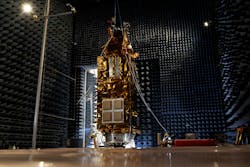ESA launches Airbus-built Biomass satellite to track global forest carbon and climate impact
KOUROU, French Guiana - The European Space Agency (ESA) has launched its flagship Biomass satellite, a mission to deliver critical data on the Earth’s forests to understand better their role in the global carbon cycle and climate change.
Built by Airbus Defence and Space, the satellite lifted off aboard a Vega-C rocket from Europe’s Spaceport in Kourou, French Guiana, on 29 April 29 at 6:15 a.m. local time. Biomass successfully separated from the launch vehicle less than an hour after liftoff. A little over an hour later, ESA’s operations team in Germany received the first signal of the satellite, relayed via a ground station in Antarctica, confirming that it was functioning as expected in orbit.
"Biomass will give scientists and climatologists unprecedented data on the state of the world’s forests, further enhancing the understanding of the climate cycle," said Alain Fauré, Head of Space Systems at Airbus Defence and Space. "The spacecraft is now safely in orbit and ready to deliver its precious data."
European Space Agency commissions world’s first space debris removal
Mission objectives
Biomass will operate over a five-year mission, utilizing the first spaceborne P-band synthetic aperture radar to penetrate forest canopies and quantify woody biomass - the trunks, branches, and stems where most forest carbon is stored. The mission aims to produce highly accurate maps of tropical, temperate, and boreal forests, supporting estimates of carbon stocks and fluxes, and helping to reduce uncertainties surrounding land-use change and forest degradation.
"Biomass now joins our esteemed family of Earth Explorers—missions that have consistently delivered groundbreaking discoveries and advanced scientific understanding of our planet," said Simonetta Cheli, ESA’s Director of Earth Observation Programs. "We are poised to gain vital new data on how much carbon is stored in the world’s forests."
Forests absorb approximately 8 billion metric tons of carbon dioxide annually, but deforestation and degradation, especially in the tropics, are releasing much of this stored carbon back into the atmosphere. Biomass will help scientists and policymakers assess these changes with unprecedented precision.
Orion Space Solutions to support NOAA's digital twin program for earth observation
Beyond forest monitoring, Biomass will support a variety of secondary objectives, including the detection of paleo aquifers in arid regions, contributing to ice sheet dynamics research, subsurface geology analysis, and refining forest topography models. Its radar system will enhance Digital Elevation Models in dense forest zones and provide a new perspective on the Earth’s surface.
More than 50 companies across 20 countries contributed to the development and testing of Biomass. ESA teams are currently overseeing the satellite’s commissioning phase, including deployment of its large radar reflector and calibration with a ground transponder located in New Norcia, Australia.
About the Author
Jamie Whitney
Senior Editor
Jamie Whitney joined the staff of Military & Aerospace Electronics in 2018 and oversees editorial content and produces news and features for Military & Aerospace Electronics, attends industry events, produces Webcasts, and oversees print production of Military & Aerospace Electronics.
